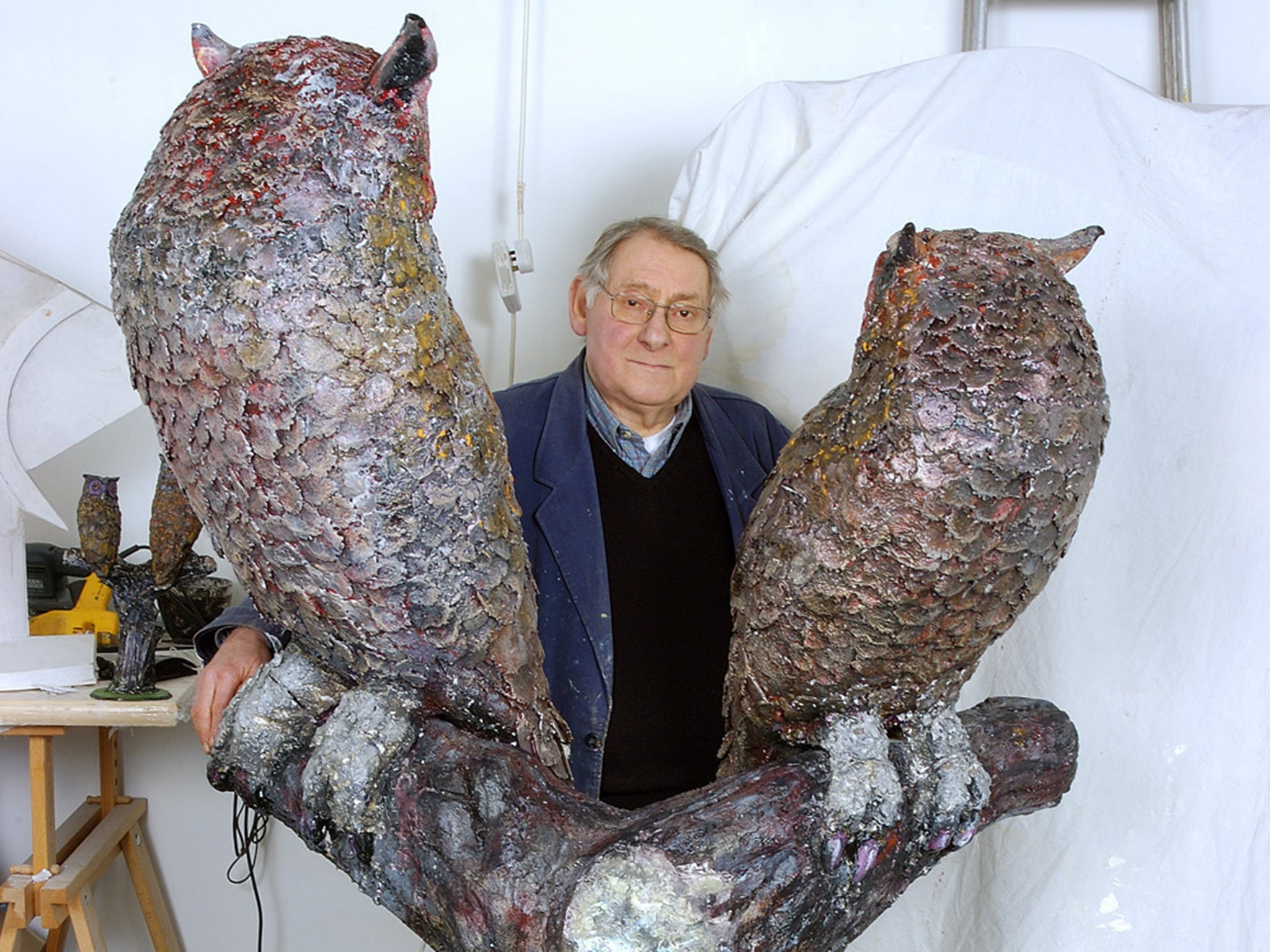Ivor Abrahams: Maverick artist acclaimed as an ‘interpreter of the suburban dream’ whose work celebrated England’s eccentricity and variety
His success rarely matched the originality which survived into his eighth decade

Ivor Abrahams was described by Andrew Lambirth as “our greatest interpreter of the suburban dream”. It was the eccentricity and variety of England he celebrated: “When you see the way other people do things in other places, they all seem to have it better organised than we do. And this is what makes this curious mixture so unique and English.”
But there was also “that aspect of the ordinary which is extraordinary”, which took his suburban interest beyond topography and made it universally applicable. Collage was pivotal to his method. “A lot of my work involves cutting things out and profiling things.”
Abrahams was a sculptor, collagist, ceramicist, print and film-maker, but his success only fitfully matched the originality which survived into his eighth decade, beginning with first prize in Southport’s 1953 Grand Parade for his Coronation float. Each decade introduced new bodies of work, from the flocked prints and sculptures in often novel materials of gardens, shrubbery, statuary and foliage-festooned garden-walls, which first afforded him to quit part-time teaching from 1970 – “I never looked back” – to totemic and cubist-influenced works in bronze, steel, copper and resin variously deployed, inspired by the sea and architecture at Ramsgate, his final home.
This restless search for new challenges and subjects made his principal art dealer, James Mayor, describe him as Europe’s equivalent of Robert Rauschenberg. Independent of any school, he has a unique artistic place.
When Abrahams was born in Wigan in 1935 his was the only Jewish family in the town. Abrahams, whose childhood visit to the exotic roof-garden at Derry & Toms in Kensington proved seminal, showed early artistic tendencies, to his mother’s pleasure and his father’s fury: “He had hoped for Perry Mason or Dr Spock, or at least an accountant in the family.”
At 17 he left for London without his parents’ consent to become a sculptor. His father refused to support him; Abrahams worked nights. He studied at St Martins and Camberwell, travelled in Europe and established his first professional contacts. He worked with Adel Rootstein, who made display mannequins and revealed the sculptural potential of nylon flocking, pre-vulcanised latex and plastics. He met Bernard Jacobson, who would be his publisher and exhibit his work with James Mayor; and in 1960, on Eduardo Paolozzi’s recommendation, he was selected for 26 Young Sculptors at the ICA. From this came his first exhibitions, one shared with Peter Blake.
Abrahams’s maverick nature now found full expression. Hard Edge abstraction and Pop Art were the fashion. What could be more contrary than English suburbia and figurative sculpture? “I always enjoyed the pomposity of academic sculpture, the grandiosity and rhetoric,” he said. “The edifying or inspirational nature of the art has always led me to treat it with the greatest disrespect.”
He had only one solo exhibition in the 1960s and depended on teaching for a living, with characteristically disruptive results. At Coventry School of Art he was sacked after his students’ water “happening” rendered the city’s fire engines inoperable; and back in London he and a friend manned a weekend whelk stall outside a celebrity pub, with the result that they were chased by an irate Sammy Davis Jnr, who demanded damages for food poisoning.
A two-year marriage, which produced his eldest child, Saul, meant that his 1970 meeting with Evelyne Horvais was especially fortuitous. They too had a son, Etienne, and remained devotedly married for the rest of his life.
The 1970s brought international fame, the catalyst an acclaimed show at Kolnischer Kunstverein in Cologne which travelled to Rotterdam. Bernard Jacobson organised an extensive print programme; for the next 10 years Abrahams produced an average of a print a month. There were regular solo shows in Europe and in America; while in England solo shows at Felicity Samuel Gallery and Mayor Gallery were supported by a series in provincial museums.
Having established this international following with the garden pieces, he flummoxed his supporters with a series of darkly emotional prints from Edgar Allen Poe and sculptures of bathing scenes in a variety of media, including painted ceramic, in the tradition of Rodin and Degas. Election to the Royal Academy coincided with the first of several animated film collaborations with his son Etienne, but a move to the Midi in 1992 was shattered by news of Saul’s death. It inspired a series of unpeopled architectural pieces, Exits and Entrances, a single lamentation.
Returned to London, he made a giant Cockerel for a Dutch international exhibition. It was bought by the Duke of Devonshire for his wife, who was “mad about chickens”. Once again Abrahams had confounded expectations, compounding it with an equally extravagant and witty use of collage to make A Parliament of Owls. There was no disguising the element of self-portraiture. In 2008 he had a critically triumphant retrospective, By Leafy Ways, at the Henry Moore Institute, and a move to Ramsgate inspired a return to suburban themes. His lifework was celebrated in 2012 with Andrew Lambirth’s monograph and a retrospective at Royal West of England Academy, Bristol.
Abrahams was a chronic asthmatic and for the last 15 years, following cancer surgery, treated himself rather than undergoing chemotherapy. It made the breadth and scale of his achievement even more heroic.
Ivor Abrahams, artist: born Wigan 10 January 1935; married 1965 Victoria Taylor (divorced 1967; one son deceased), 1974 Evelyne Horvais (one son); died 6 January 2015.
Join our commenting forum
Join thought-provoking conversations, follow other Independent readers and see their replies
Comments